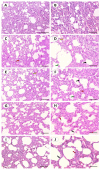Roles of Nrf2/HO-1 and ICAM-1 in the Protective Effect of Nano-Curcumin against Copper-Induced Lung Injury
- PMID: 37762280
- PMCID: PMC10531221
- DOI: 10.3390/ijms241813975
Roles of Nrf2/HO-1 and ICAM-1 in the Protective Effect of Nano-Curcumin against Copper-Induced Lung Injury
Abstract
Copper (Cu) is an essential trace element for maintaining normal homeostasis in living organisms. Yet, an elevated level of Cu beyond homeostatic capacity may lead to oxidative damage of cellular components in several organs, including the lungs. This work investigated the effects of curcumin (Curc) and nano-curcumin (nCurc) against Cu-induced lung injury, accenting the roles of oxidative stress, inflammation, and the nuclear factor erythroid 2-related factor/heme oxygenase-1 Nrf2/HO-1 pathway. Rats were challenged with 100 mg/kg of copper sulfate (CuSO4) while being treated with Curc or nCurc for 7 days. Cu-triggered lung oxidative stress detected as dysregulation of oxidative/antioxidant markers, a downregulation of Nrf-2/HO-1 signaling, and an increase in the inflammatory markers interleukin-6 (IL-6), tumor necrosis factor-alpha (TNF-α), and intracellular adhesion molecule-1 (ICAM-1). Additionally, it decreased the expression of lung-specific proteins, surfactant protein-C (SP-C), and mucin-1 (MUC-1), induced apoptosis, and caused changes in lung histology. Curc and nCurc alleviated CuSO4-induced lung injury by suppressing oxidative damage and inflammation and activating Nrf-2/HO-1. They also prevented apoptosis and restored the normal expression of SP-C and MUC-1. We concluded that nCurc exhibited superior efficacy compared with Curc in mitigating CuSO4-induced lung injury. This was associated with reduced oxidative stress, inflammation, and apoptotic responses and increased Nrf2/HO-1 signaling and expression of SP-C and MUC-1.
Keywords: ICAM-1; Nrf2/HO-1 pathway; copper sulfate; curcumin; inflammation; lung toxicity; oxidative stress.
Conflict of interest statement
The authors declare no conflict of interest.
Figures






References
MeSH terms
Substances
Grants and funding
LinkOut - more resources
Full Text Sources
Research Materials
Miscellaneous

